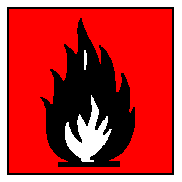International Chemical Safety Cards
| 2-BUTENE (MIXED ISOMERS) | ICSC: 0838 |
| 2-BUTENE (MIXED ISOMERS) beta-Butylene Pseudo-butylene 1,2-Dimethylethylene (cylinder) CH3CH=CHCH3/C4H8 Molecular mass: 56.1 CAS # 107-01-7 RTECS # EM2932000 ICSC # 0838 UN # 1012 EC # 601-012-00-4 |
 |
| TYPES OF HAZARD/ EXPOSURE |
ACUTE HAZARDS/ SYMPTOMS |
PREVENTION | FIRST AID/ FIRE FIGHTING |
| FIRE | Extremely flammable. |
NO open flames, NO sparks,
and NO smoking. |
Shut off supply; if not
possible and no risk to surroundings, let the fire burn itself out; in other cases
extinguish with water spray, foam, or dry chemical. |
| EXPLOSION | Gas/air mixtures are
explosive. |
Closed system, ventilation,
explosion-proof electrical equipment and lighting. Prevent build-up of electrostatic
charges (e.g., by grounding). Use non-sparking handtools. |
In case of fire: keep
cylinder cool by spraying with water. Combat fire from a sheltered position. |
| EXPOSURE | |
|
|
| INHALATION | Dizziness. Unconsciousness.
|
Ventilation, local exhaust,
or breathing protection. |
Fresh air, rest. Refer for
medical attention. |
| SKIN | ON CONTACT WITH LIQUID:
FROSTBITE. |
Cold-insulating gloves. |
ON FROSTBITE: rinse with
plenty of water, do NOT remove clothes. Refer for medical attention. |
| EYES | |
Face shield. |
First rinse with plenty of
water for several minutes (remove contact lenses if easily possible), then take to a
doctor. |
| INGESTION | |
Do not eat, drink, or smoke
during work. |
|
| SPILLAGE DISPOSAL | STORAGE | PACKAGING & LABELLING | ||
| Evacuate danger area!
Consult an expert! Ventilation. NEVER direct water jet on liquid (extra personal
protection: self-contained breathing apparatus). |
Fireproof. Separated from
acids. Cool. |
F symbol R: 13 S: 9-16-33 UN Hazard Class: 2.1 |
||
| SEE IMPORTANT INFORMATION ON BACK | ||||
|
||||